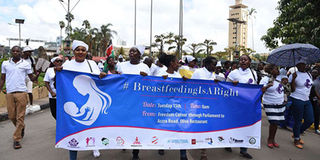Breastfeeding helps fend off breast, ovarian cancers

Nairobi women participate in a breastfeeding awareness activity. PHOTO | FILE | NATION MEDIA GROUP
What you need to know:
- Breastfeeding also offers protection against ovarian cancer, rheumatoid arthritis, and type two diabetes.
- Dr Mutuma said breast cancer is the second leading cause of cancer deaths among women.
Failing to breastfeed is a risk factor for breast, ovarian and uterine cancers.
Dr Geoffrey Mutuma, the head of oncology and pathology research at the Kenya Medical Research Institute (Kemri), said women who give birth over the age of 30 are more susceptible to breast cancer.
According to Dr Mutuma, breastfeeding reduces the risk of breast cancer primarily through two mechanisms.
One way is that the human milk scientifically known as hamlet induces the death of tumour cells found in the breasts.
He says clinical research has proven that the complex components of human milk secretion lower the risk of breast cancer in women who breastfeed their babies exclusively for a certain period of time.
OVULATORY CYCLES
As a result, the hamlet provides protection against the development of breast cancer.
Breastfeeding also offers protection against ovarian cancer, rheumatoid arthritis, and type two diabetes.
Another way in which breastfeeding reduces chances of getting cancer, according to Dr Mutuma, is because of the differentiation of breast tissues and reduction of lifetime number of ovulatory cycles.
“I would urge women, especially working mothers, to breastfeed exclusively for at least six months.
"This will not only be beneficial to the baby, but also to the mother as it lowers the chances of getting breast cancer,” Dr Mutuma, who is a former chief government pathologist and founder of Nairobi Cancer Registry, said.
AGE
Many women fear that if they breastfeed, they would have sagging breasts.
However, researchers confirm that breastfeeding doesn't make breasts wilt more.
In a 2007 study of 132 women, breastfeeding did not have a significant effect on breast ptosis, the medical term for sagging breasts.
But age, smoking and the number of pregnancies a woman had contributed to the shape of their breasts.
According to University of Kentucky's plastic surgeon and researcher Brian Rinker, the older a woman is and the more pregnancies she's had the more her breasts are likely to shrink.
"Women may be reluctant to breastfeed because of this unfounded myth that doing so means the end of youthful breasts," Rinker said.
"Now, expectant mothers can relax knowing breastfeeding does not sacrifice the appearance of their breasts, but helps in preventing breast cancer.
FATALITIES
Dr Mutuma said breast cancer is the second leading cause of cancer deaths among women.
“In every nine women in Kenya, one will have breast cancer. Hormonal changes are the major cause of different cases affecting a woman.
"I would urge every woman in the childbearing age to go for cancer screening and vaccination,” he said.
Breast and cervical are the most commonly diagnosed cancers among women. Breast cancer affects 34 out of 100,000 people while cervical cancer affects 25 out of 100,000 people.





